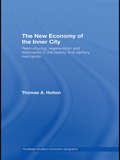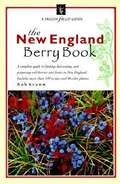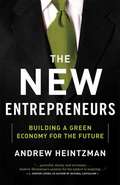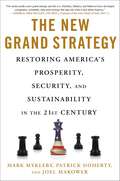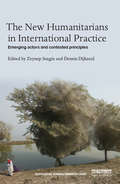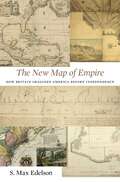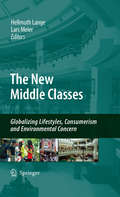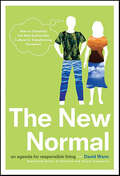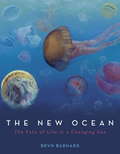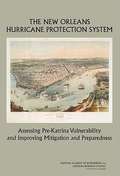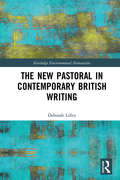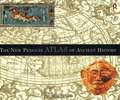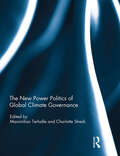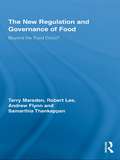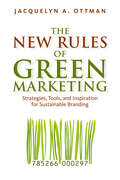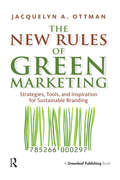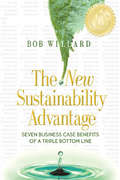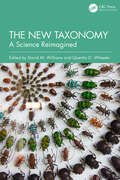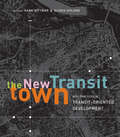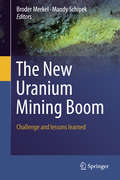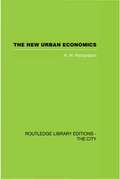- Table View
- List View
The New Economy of the Inner City: Restructuring, Regeneration and Dislocation in the 21st Century Metropolis (Routledge Studies in Economic Geography)
by Thomas A. HuttonFollowing the restructuring process which swept away the traditional manufacturing economy of the inner city 25 years ago, new industries are transforming these former post-industrial landscapes. These creative, technology-intensive industries include Internet services, computer graphics and imaging, and video game production. The development dynamics of these new sectors are volatile in comparison with those of the classic ‘Industrial City’. But these new industries highlight the unique role of the inner city in facilitating creative processes, innovation and social change. Further, they reflect the intensity of interaction between the ‘global’ and the ‘local’ in the metropolis, and represent key agencies of urban place-making and re-imaging. This book addresses the critical intersections between process and place which underpin the formation of creative enterprises in the emergent industrial districts of the ‘new inner city’. It contains intensive case studies of industrial restructuring within exemplary sites in prominent world cities such as London, Singapore, San Francisco and Vancouver. The studies demonstrate the global reach of development and innovation across these cities and sites, marked by clustering, rapid firm turnover, and interdependency between production and consumption activity. The evocative case studies, brought to life by interviews, sequential mapping exercises, media narratives, and photography, also disclose the importance of local factors (including urban scale, built form, property markets and policy) which shape both the specific industrial structures and socio-economic impacts. The New Economy of the Inner City places inner city new industry formation within the development history of the city, and underscores its role in larger processes of urban transformation. The findings inform a critique and synthesis of urban theory which frame the evolving conditions of the 21st century metropolis. This book would be useful to researchers and students of Geography, Urban Studies, Economics and Planning.
The New England Berry Book
by Bob KrummContains a guide and recipes for wild blueberries, huckleberries, blackberries, black currants, black raspberries, beach plum, chokecherries, juneberries, elderberries, red raspberries, cranberries, and strawberries.
The New Entrepreneurs: Building a Green Economy for the Future
by Andrew HeintzmanIn The New Entrepreneurs, author and venture capitalist Andrew Heintzman introduces us to the innovative business leaders who are at the forefront of the green economy. From forestry, water, and energy to transportation and agriculture, Heintzman profiles the enterprises that are developing cutting-edge, clean-tech products and innovations for export to a vast and rapidly expanding global market. In a world that faces growing threats of climate change, peak oil, and resource scarcity, Heintzman shares his vision of a new and prosperous way forward. Highly engaging and a powerful call to action, The New Entrepreneurs offers a fresh and visionary approach to redesigning our current economic system, one that uses the powerful forces of capitalism to act as a catalyst for broad social change.
The New Grand Strategy: Restoring America's Prosperity, Security, and Sustainability in the 21st Century
by Joel Makower Patrick Doherty Mark MyklebyThe New Grand Strategy tells the story of a plan, born within the Pentagon, to recapture America’s greatness at home and abroad by elevating sustainability as our new strategic imperative. It aligns our enduring national interests of prosperity and security with a new framework that addresses pressing economic, social, and environmental issues at home, tapping into a trillion-dollar market demand for walkable communities, regenerative agriculture and resource productivity. It is an inspiring vision of what’s possible when Americans hold a collective view of the future and come together to bring it to reality.This is no idealistic pipe dream or wonky policy prescription. The story that unfolds in this book weaves together hard-nosed economic analysis, a clear-eyed study of demographic and societal shifts, the realities of climate change and resource scarcity, a risk-based assessment of America’s challenges and opportunities, and on-the-ground reporting of how much this is already unfolding throughout the country. By rediscovering the power and discipline of grand strategy—and taking responsibility for our future—America can reimagine the American dream and once again take on “the cause of all mankind.”Released during one of America’s most divisive presidential election campaigns, The New Grand Strategy avoids the partisan rhetoric dividing our nation today. Instead of placing blame, it offers a clear, pragmatic plan that can unite Americans and launch a new era of prosperity and security.
The New Humanitarians in International Practice: Emerging actors and contested principles (Routledge Humanitarian Studies)
by Dennis Dijkzeul Zeynep SezginAs humanitarian needs continue to grow rapidly, humanitarian action has become more contested, with new actors entering the field to address unmet needs, but also challenging long-held principles and precepts. This volume provides detailed empirical comparisons between emerging and traditional humanitarian actors. It sheds light on why and how the emerging actors engage in humanitarian crises and how their activities are carried out and perceived in their transnational organizational environment. It develops and applies a conceptual framework that fosters research on humanitarian actors and the humanitarian principles. In particular, it simultaneously refers to theories of organizational sociology and international relations to identify both the structural and the situational factors that influence the motivations, aims and activities of these actors, and their different levels of commitment to the traditional humanitarian principles. It thus elucidates the role of the humanitarian principles in promoting coherence and coordination in the crowded and diverse world of humanitarian action, and discusses whether alternative principles and parallel humanitarian systems are in the making. This volume will be of great interest to postgraduate students and scholars in humanitarian studies, globalization and transnationalism research, organizational sociology, international relations, development studies, and migration and diaspora studies, as well as policy makers and practitioners engaged in humanitarian action, development cooperation and migration issues.
The New Map of Empire: How Britain Imagined America before Independence
by S. Max EdelsonIn 1763 British America stretched from Hudson Bay to the Keys, from the Atlantic to the Mississippi. Using maps that Britain created to control its new lands, Max Edelson pictures the contested geography of the British Atlantic world and offers new explanations of the causes and consequences of Britain’s imperial ambitions before the Revolution.
The New Middle Classes
by Hellmuth Lange Lars MeierThe new middle classes of developing countries are held responsible for boosting extremely resource-intensive lifestyles beyond the OECD-world thus thwarting ongoing efforts to attain a more sustainable future. But how homogeneous are their consumption patterns and why should not globalization include the extension of environmental concern, too? "The New Middle Classes" challenges a narrow understanding of lifestyles and consumption by analyzing the issue not only in terms of attitudes and preferences but of socio-economic features and governmental policies, too.
The New Normal: An Agenda for Responsible Living
by David WannIn Simple Prosperity, Dave Wann showed readers how to have an abundant, sustainable life. In The New Normal, he challenges us to do some heavy lifting and transform our non-sustainable culture by transforming ourselves. For Wann, our current "old normal" lifestyle - buying water in disposable bottles, allowing the government to ignore global warming - will not preserve the planet. To nurture our world, he challenges us to rethink our lives, stand up for a healthy planet and move towards a "new normal" lifestyle in an agenda that includes:- Initiating local business alliances that actively lobby for local buying.- Creating an investment strategy that values the balance of nature.- Supporting the design, manufacture, and use of products made with natural chemicals.- Publicly advocating a more efficient use of water by placing a higher cultural value on wetlands, streams, rivers, and lakes.The New Normal is Dave Wann's way forward, a blueprint for a better life that preserves our world.
The New Ocean: The Fate of Life in a Changing Sea
by Bryn BarnardA fascinating look at the future of our oceans—and how human actions may change them. The Earth—our home—is covered mostly with water: the wide, deep, salty, and very blue ocean. It regulates our climate in a way that makes life as we know it possible. This huge ocean is full of an amazing amount of life, most of which is too small to see. But life in the ocean is in trouble. The ocean is becoming hotter, more polluted, and, in places, empty of life. The right amount of warming is good for us, but too much warming is causing shifts that are not good for life in the ocean. Global warming, pollution, and overfishing are creating a New Ocean, in which life is changing drastically. This book tells the stories of the probable fates of six sea dwellers: jellyfish, orcas, sea turtles, tuna, corals, and blue-green algae. What becomes of them may help you understand what becomes of us.
The New Orleans Hurricane Protection System: Assessing Pre-Katrina Vulnerability and Improving Mitigation and Preparedness
by National Academy of Engineering National Research Council of the National AcademiesHurricane Katrina, which struck New Orleans and surrounding areas in August 2005, ranks as one of the nation's most devastating natural disasters. Shortly after the storm, the U.S. Army Corps of Engineers established a task force to assess the performance of the levees, floodwalls, and other structures comprising the area's hurricane protection system during Hurricane Katrina. This book provides an independent review of the task force's final draft report and identifies key lessons from the Katrina experience and their implications for future hurricane preparedness and planning in the region.
The New Pastoral in Contemporary British Writing (Routledge Environmental Humanities)
by Deborah LilleyThis book identifies a major turn in contemporary British literature in response to environmental crisis. It argues that the pastoral is emerging as a new critical framework in which to explore the understanding of people and place in this context. The New Pastoral in Contemporary British Writing explores how the pastoral tradition has transformed as authors respond to our changing relationships with place in this period. Analysing the features common to new pastoral writing, it brings together a corpus of works from major authors including Ali Smith, Jim Crace, John Burnside, Kathleen Jamie, and Robert Macfarlane. This book argues that crises such as pollution and climate change have shifted our understandings of the key relationships of pastoral and the terms upon which they are based, giving new senses to its older oppositions between the human and the natural, the urban and the rural, and the past and the present. Furthermore, it shows that the versions of pastoral that ensue align with current ecocritical arguments produced by thinking through the individual, cultural, and ecological implications of environmental crisis. As a result, pastoral emerges as the crucial strategy in the re-imagining of the environment underway in contemporary British writing, the resurgence of interest in nature writing, the increasing attention towards place in literary fiction, and the development of ecological or ‘climate’ fiction. This book will be of great interest to students and scholars of English as well as those concerned with the interdisciplinary topics of the environmental humanities, including literary geographies, new nature writing, cultures of climate change and the Anthropocene, and ecologically-oriented theory.
The New Penguin Atlas of Ancient History
by John Woodcock Colin McevedyThe Penguin Atlas of Ancient History illustrates in a chronological series of maps, the evolution and flux of races in Europe, the Mediterranean area and the Near East. From 50,000 B. C. to the fourth century A. D. , it is one of the most successful of the bestselling historical atlas series.
The New Power Politics of Global Climate Governance
by Maximilian Terhalle Charlotte StreckThis book is based on the assumption that great powers determine global politics and, in this instance, environmental politics. It addresses the approaches of both established and rising powers and their implications for the advancement of international climate negotiations. The new introduction looks at the key developments in this realm since 2013, examining the bilateral deals between China and the United States and the results of the UNFCCC’s 21st Convention of the Parties (COP) convening at Paris in 2015. Two key features link the contributions of this volume: their underlying assumption that major powers are the central actors in determining global environmental politics; and their assessment of, and implications of, the approaches both of rising and established major powers for global climate norms. One key argument of this volume is that today’s geopolitics are about who gets how much in the fiercely competitive race over the available ‘carbon space’. The book concludes that prudently balancing power in the new century requires a fair sharing of burden among the existing and emerging powers. In light of such burden-sharing, pluralistic domestic politics as well as diverging normative beliefs and worldviews require consideration of different conditions, even if historical legacies of the industrialised world have increasingly been put into question as a political argument by the United States.This book is based on a special issue of the journal Climate Policy.
The New Regulation and Governance of Food: Beyond the Food Crisis? (Routledge Studies in Human Geography)
by Robert Lee Terry Marsden Andrew Flynn Samarthia ThankappanMajor questions surround who, how, and by what means should the interests of government, the private sector, or consumers hold authority and powers over decisions concerning the production and consumption of foods. This book examines the development of food policy and regulation following the BSE (mad cow disease) crisis of the late 1990s, and traces the changing relationships between three key sets of actors: private interests, such as the corporate retailers; public regulators, such as the EU directorates and UK agencies; and consumer groups at EU and national levels. The authors explore how these interests deal with the conundrum of continuing to stimulate a corporately organised and increasingly globalised food system at the same time as creating a public and consumer-based legitimate framework for it. The analysis develops a new model and synthesis of food policy and regulation which reassesses these public/private sector responsibilities with new evidence and theoretical insights.
The New Rules of Green Marketing: Strategies, Tools, and Inspiration for Sustainable Branding
by Jacquelyn A. OttmanGreen products have been around since the 1970s, but it's only in recent years that they've become ubiquitous. That's because savvy green marketers are no longer targeting "deep green" consumers with a "save the planet" pitch. Instead, they're promoting the added value their products provide: better health, superior performance, good taste, or cost-effectiveness. In this innovative book Ottman argues that emphasizing primary benefits -- the New Rules -- is critical to winning over the mainstream consumer.Drawing on the latest poll data and incorporating lessons learned from her clients and other leading sustainable brands -- including GE, Nike, Method, Starbucks, Timberland, HP, NatureWorks, Procter & Gamble, Stonyfield Farm, and Wal-Mart -- Ottman provides practical strategies, tools, and inspiration for building every aspect of a credible value-based green marketing strategy. She covers such topics as spurring innovation through a proactive approach to sustainability, developing products that are green throughout their life cycle, communicating credibly to avoid accusations of "greenwashing," teaming up with stakeholders to maximize outreach to consumers, taking advantage of social media, and much more.The New Rules of Green Marketing captures the best of Ottman's two previous groundbreaking books on green marketing and places it within a 21st Century context. Focusing on a new generation of marketers who likely grew up with an appreciation for sustainability, it provides in one place essential strategies, tools, and inspiration for connecting effectively with mainstream consumers.
The New Rules of Green Marketing: Strategies, Tools, and Inspiration for Sustainable Branding
by Jacquelyn OttmanFor too long, marketers of sustainable goods and services have targeted "deep green" consumers to promote their products – and they have little to show for their efforts. In this innovative book, Jacquelyn Ottman shows how the green market has moved beyond such niche marketing, and how marketers will find greater success promoting the inherent superior value of their offerings. Greener products are now available within every industry and are a part of our everyday lives. But they didn't get to be so ubiquitous just because they are better for the planet. Whether they were promoted as such or not, sales of green products have grown so fast because of the added value they provide: health, superior performance, good taste, cost-effectiveness, or simply convenience. This central emphasis on primary benefits – the new rules – is critical to winning over the mainstream consumer and to driving overall organizational growth. The New Rules of Green Marketing helps readers understand why value-based sustainability marketing has become a critical organizational capacity, and how readers can adopt this approach in their own organizations. Illustrated by examples from both international mainstream and the more niche "deep green" leaders who are showing everyone else the way, the book provides practical strategies, tools and inspiration for building every aspect of a credible value-based green marketing strategy, including:How to use a proactive approach to sustainability to spur innovationHow to frame environment-related benefits with relevance to mainstream brandsHow to communicate with credibility and impact – and avoid "greenwashing"How to team up with stakeholders to maximize outreach to consumersHow to use a life cycle orientation to ensure the integrity of one's offeringsHow to best take advantage of recent technological advances in social mediaDrawing on the latest data from leading researchers and reflecting on learnings from Ottman's corporate clients and other pioneers including GE, Nike, HSBC, Method, Starbucks, Timberland, HP, NatureWorks, Philips, Procter & Gamble, Stonyfield Farm and Wal-Mart, this book shows how market leaders are edging out the competition using effective value-first marketing strategies. This book captures the best of the author's previous groundbreaking books on green marketing and takes the content into the 21st century. Whereas earlier works focused on readers who were less familiar with green initiatives, this work squarely focuses on a new generation of marketers who likely themselves grew up with an appreciation of sustainability and who want and need to know how to connect effectively with mainstream consumers.
The New Sustainability Advantage
by Bob WillardThe New Sustainability Advantage shows how the benefits of the "triple bottom line" can increase a typical company's profits by fifty-one to eighty-one percent within five years, depending on the company's size and industry sector, while avoiding risks that could jeopardize its financial well-being.Fully revised and updated, this tenth anniversary edition clearly demonstrates that, by focusing on seven powerful yet easy to grasp sustainability strategies, businesses can:Increase revenueImprove productivityReduce expensesDecrease risksExpressed in clear business language and presented in an appealing, graphically rich format, this practical guide and the accompanying online Sustainability Advantage Simulator Dashboard enables executives to enter their own data and quickly identify the high-leverage benefit areas for their organization. More detailed downloadable spreadsheets help them drill down into specific areas of interest and fine-tune the assumptions to their specific situation.An indispensable tool for both sustainability champions and senior management, The New Sustainability Advantage proves that the quantified business case for sustainability is more compelling than ever before.Bob Willard gave up an award-winning successful career in senior management at IBM to devote himself full-time to building corporate commitment to sustainability. Widely in demand as a speaker, he has delivered hundreds of presentations demonstrating the business case for sustainability to companies, consultants, academics, and NGOs worldwide. Bob is the author of The Sustainability Champion's Guidebook, The Next Sustainability Wave, and the original edition of The Sustainability Advantage.
The New Taxonomy: A Science Reimagined
by Quentin D. Wheeler David M. WilliamsToday molecular data is part of many biological studies, including taxonomic works. Such data is embraced by taxonomists for good reasons. When combined with comparative morphology, palaeontology, and embryology, it creates a rich, integrated overview of the history of life. This book is intended as a clear articulation of the mission, goals, and needs of fundamental taxonomists and a planetary-scale inventory of species by revisiting the idea of taxonomy as a fusion of the traditional questions asked by taxonomists and the latest technologies. It is a clear roadmap to a taxonomic renaissance and world species inventory.Key Features: Establishes the role and responsibilities of natural history museums to baseline taxonomic studies Emphasizes the potential of ‘descriptive’ taxonomy Proposes a cyberinfrastructure specifically designed to meet the needs of taxonomists to do taxonomy Provides a clear statement of taxonomy’s mission, goals, and prospects Reviews taxonomic philosophies and codes of nomenclature from an historical perspective
The New Transit Town: Best Practices In Transit-Oriented Development
by Hank Dittmar Gloria OhlandTransit-oriented development (TOD) seeks to maximize access to mass transit and nonmotorized transportation with centrally located rail or bus stations surrounded by relatively high-density commercial and residential development. New Urbanists and smart growth proponents have embraced the concept and interest in TOD is growing, both in the United States and around the world.New Transit Town brings together leading experts in planning, transportation, and sustainable design--including Scott Bernstein, Peter Calthorpe, Jim Daisa, Sharon Feigon, Ellen Greenberg, David Hoyt, Dennis Leach, and Shelley Poticha--to examine the first generation of TOD projects and derive lessons for the next generation. It offers topic chapters that provide detailed discussion of key issues along with case studies that present an in-depth look at specific projects. Topics examined include:*the history of projects and the appeal of this form of development*a taxonomy of TOD projects appropriate for different contexts and scales*the planning, policy and regulatory framework of "successful" projects*obstacles to financing and strategies for overcoming those obstacles*issues surrounding traffic and parking*the roles of all the actors involved and the resources available to them*performance measures that can be used to evaluate outcomesNew Transit Town explores the key challenges to transit-oriented development, examines the lessons learned from the first generation of projects, and uses a systematic examination and analysis of a broad spectrum of projects to set standards for the next generation. It is a vital new source of information for anyone interested in urban and regional planning and development, including planners, developers, community groups, transit agency staff, and finance professionals.
The New Uranium Mining Boom
by Broder Merkel Mandy SchipekThe book presents the results from the Uranium Mining and Hydrogeology Conference (UMH VI) held in September 2011, in Freiberg, Germany. The following subjects are emphasised: Uranium Mining, Phosphate Mining and Uranium recovery. Cleaning up technologies for water and soil. Analysis and sensor for Uranium and Radon and Modelling.
The New Uranium Mining Boom: Challenge and lessons learned (Springer Geology)
by Broder Merkel Mandy SchipekThe book presents the results from the Uranium Mining and Hydrogeology Conference (UMH VI) held in September 2011, in Freiberg, Germany. The following subjects are emphasised: Uranium Mining, Phosphate Mining and Uranium recovery. Cleaning up technologies for water and soil. Analysis and sensor for Uranium and Radon and Modelling.
The New Urban Frontier: Gentrification and the Revanchist City
by Neil SmithWhy have so many central and inner cities in Europe, North America and Australia been so radically revamped in the last three decades, converting urban decay into new chic? Will the process continue in the twenty-first century or has it ended? What does this mean for the people who live there? Can they do anything about it? This book challenges conventional wisdom, which holds gentrification to be the simple outcome of new middle-class tastes and a demand for urban living. It reveals gentrification as part of a much larger shift in the political economy and culture of the late twentieth century. Documenting in gritty detail the conflicts that gentrification brings to the new urban 'frontiers', the author explores the interconnections of urban policy, patterns of investment, eviction, and homelessness. The failure of liberal urban policy and the end of the 1980s financial boom have made the end-of-the-century city a darker and more dangerous place. Public policy and the private market are conspiring against minorities, working people, the poor, and the homeless as never before. In the emerging revanchist city, gentrification has become part of this policy of revenge.
The New Wider World
by David WaughThis bestselling text offers both teacher and students the assurance that its new enriched content and range of material meets the exacting requirements of the latest GCSE and Standard Grade examinations.
The New Wild
by Fred PearceA provocative exploration of the "new ecology" and why most of what we think we know about alien species is wrong For a long time, veteran environmental journalist Fred Pearce thought in stark terms about invasive species: they were the evil interlopers spoiling pristine "natural" ecosystems. Most conservationists and environmentalists share this view. But what if the traditional view of ecology is wrong--what if true environmentalists should be applauding the invaders? In The New Wild, Pearce goes on a journey across six continents to rediscover what conservation in the twenty-first century should be about. Pearce explores ecosystems from remote Pacific islands to the United Kingdom, from San Francisco Bay to the Great Lakes, as he digs into questionable estimates of the cost of invader species and reveals the outdated intellectual sources of our ideas about the balance of nature. Pearce acknowledges that there are horror stories about alien species disrupting ecosystems, but most of the time, the tens of thousands of introduced species usually swiftly die out or settle down and become model eco-citizens. The case for keeping out alien species, he finds, looks increasingly flawed. As Pearce argues, mainstream environmentalists are right that we need a rewilding of the earth, but they are wrong if they imagine that we can achieve that by reengineering ecosystems. Humans have changed the planet too much, and nature never goes backward. But a growing group of scientists is taking a fresh look at how species interact in the wild. According to these new ecologists, we should applaud the dynamism of alien species and the novel ecosystems they create. In an era of climate change and widespread ecological damage, it is absolutely crucial that we find ways to help nature regenerate. Embracing the new ecology, Pearce shows us, is our best chance. To be an environmentalist in the twenty-first century means celebrating nature's wildness and capacity for change.From the Hardcover edition.
